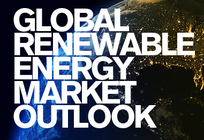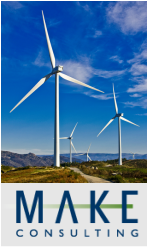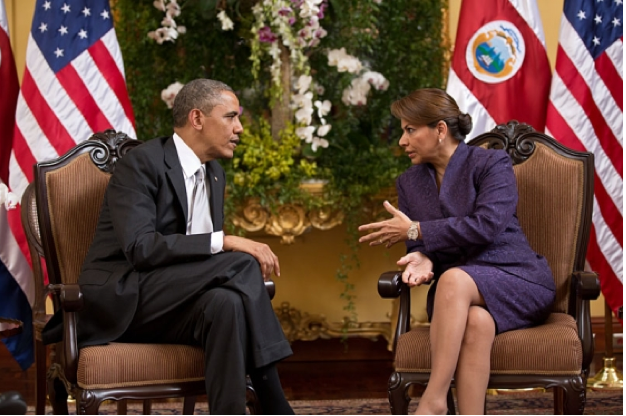
|
|
|
In joint press conferences, President Obama of the U.S., President Pena Nieto of Mexico, and President Chinchilla of Costa Rica highlight the importance of clean energy partnerships:
 Clean energy investment in non-Brazil Latin America totaled $4.7 billion in 2012, a 127% increase from 2011, according to Bloomberg New Energy Finance, while total clean energy investment in Latin America, including Brazil, reached $9.7 billion. With the dramatic growth in investment in non-Brazil Latin America, the region was a leader in a year when global clean energy investment declined 11%. (More on global trends here.) The most growth occurred in Mexico ($1.9 billion, up 595%), Chile ($1 billion, up 313%), Uruguay ($105 million, up 285%), and Peru ($643 million, up 176%). The investment totals include investments in energy generation technologies and biofuels. The investment growth in non-Brazil Latin America was "driven by increased activity by the Inter-American Development Bank,” said Maria Gabriela da Rocha Oliveira, Head of Latin America Research and Analysis at BNEF, in an ACORE press release. “Additionally, European players, both project developers and manufacturers, have become more active in the region given grim conditions at home.” Brazil, Latin America’s largest economy, attracted the most capital in the region, $5.17 billion, but this figure represents a significant decline from the $7.8 billion invested in Brazil in 2011. This decline is reportedly due in part to the funding disbursement cycles of the development banks that provide the majority of asset finance in the region.  Non-hydro renewables will account for the majority of new power capacity added by 2030 worldwide, according to new research by analysts at Bloomberg New Energy Finance. Despite current difficult market conditions, Bloomberg New Energy Finance also projects a 230% jump in investment in clean energy assets (including power, biofuels, and heat) to $630bn per year by 2030.  Renewables 100 Policy Institute, World Future Council and World Wind Energy Association are among the groups behind a new push to promote a global shift to 100% clean energy.  Clean energy continued to gain ground in the global energy mix in 2012, according to the latest edition of Who's Winning the Clean Energy Race. While global investment in clean energy dropped 11% to $269 billion, there was record installation of new clean energy generating capacity worldwide, driven in part by significant declines in technology prices. Globally, 88 gigawatts (GW) of new clean energy generating capacity was added, and by the end of 2012, 648 GW was in place globally (Figure 1). Notably, clean energy markets in smaller countries increased by 52% to more than $20 billion. This trend is likely to continue: Bloomberg New Energy Finance projects continued annual growth for clean energy of 10 to 18 percent in developing markets, including Latin America, through 2020. In the Americas, the data shows investment volatility as well as the growth of emerging Latin American markets. The report found that investment fell in the Americas overall, with clean energy financing down 31 percent in 2012, to $50.3 billion. However, this decline followed growth of more than 30 percent in 2011, illustrating a pattern of investment volatility in the region. The top 10 countries in global clean energy investment included the United States at $35.6 billion (#2 rank) and Brazil at $5.3 billion (#10 rank). Investment in Argentina and Mexico grew by 63% and 548% respectively.  The Americas region is expected to add nearly 92GW of new wind power capacity from 2013 to 2020, but the rate of growth will differ dramatically between North America and Latin America, according to a new report by MAKE Consulting. "The real opportunity over the next eight years will be in Latin America," states the report. MAKE forecasts a 20 percent compounded annual growth rate in Latin America and projects that, for the first time, the majority of new wind capacity in the Americas will occur outside of the U.S. market. The report also projects that the U.S. and Brazil markets will together account for over 26GW of installations in 2013-2016, with a bubble year expected in 2014.  Driven by the U.S., Canada, and Brazil, wind installations in the Americas grew by more than 12% in 2012, compared with 2011, according to Navigant Research's World Wind Market Update. The American continent captured more than 35% of the global wind market in 2012.  The Caribbean Community (CARICOM) has established new targets for the incorporation of renewable energy in to the region's energy mix. The initial targets are: 20%, 28% and 47% by 2017, 2022 and 2027, respectively, for the contribution of renewable energy to total electricity generation in the region. The high cost of energy and the overdependence on expensive imported fossil fuels are contributing to the drive to adopt new clean energy technologies. It is estimated that more than 90% of the region’s commercial energy consumption comes from petroleum products, according to the announcement.  Latin America holds some of the world’s richest geothermal resources, with total potential estimated at 35,500 megawatts (MW), according to the International Renewable Energy Agency. A significant portion of this is concentrated in the Andean sub-region, consisting of Bolivia, Chile, Colombia, Ecuador and Peru, all with vast potential yet limited development in geothermal energy. |
Categories
All
Archives
January 2025
Blogroll
|
|
© 2013 - 2025 InterAmerican Clean Energy Institute, a project of Earth Ways Foundation Inc, a 501(c)3 nonprofit organization.
|
Web Hosting by iPage
|

 RSS Feed
RSS Feed